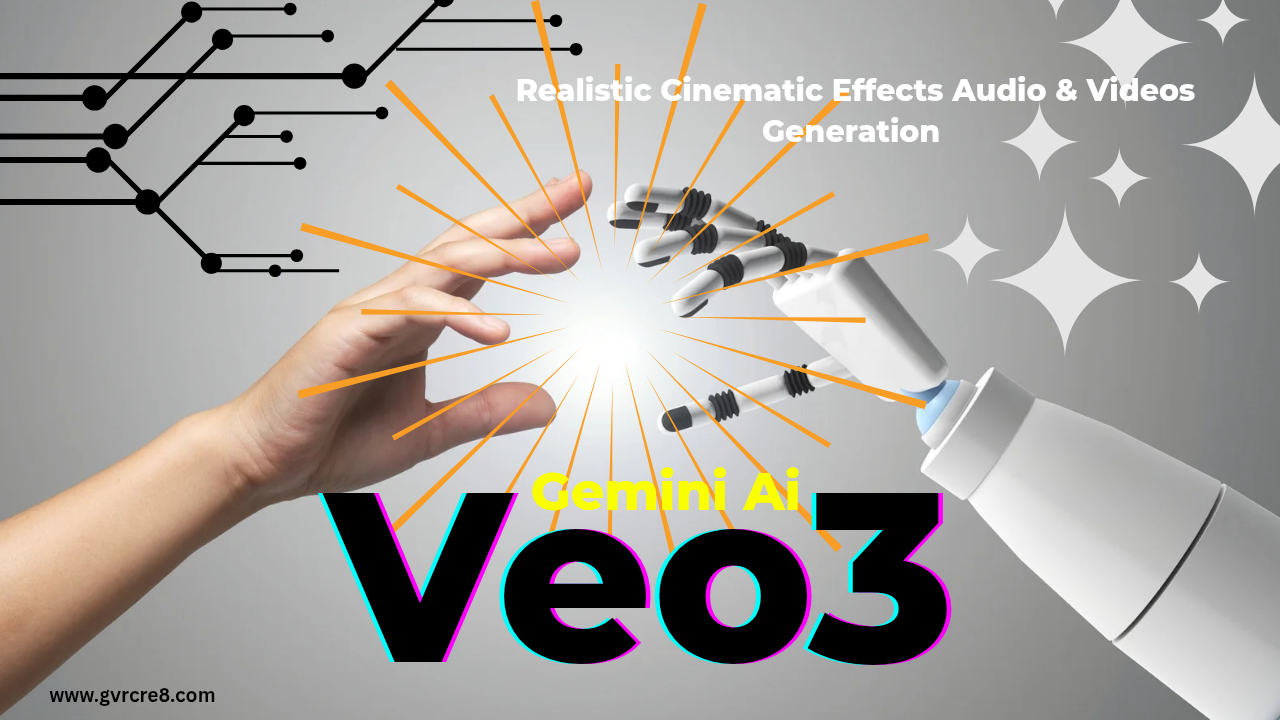🔍 What is Veo 3?
Veo is Google DeepMind’s cutting-edge text‑to‑video model. After debuting Veo in May 2024 and following up with the high‑resolution Veo 2 in late 2024, Veo 3 launched in May 2025 with one major leap: it now generates synchronized audio—ambient sounds, music, even dialogue—alongside compelling visuals.
Key highlights:
-
Text→Video with Audio: Unlike previous generations that created silent clips, Veo 3 embeds native audio effects—ambience, music, speech.
-
Cinematic Realism: Stronger physics, realistic motion, and accurate lip sync, making short-film quality possible.
-
Workflow Integration: Part of Gemini and Google’s new Flow interface for film-style editing.
💡 Why Veo 3 Matters
-
Breaks the “Silent Era” – With audio embedded from the get-go, Veo 3 bridges visual storytelling with immersive sound, a first in consumer-grade AI video generation.
-
Synchronized Dialogue – Characters can speak lines you type. Lip-sync quality makes narrative clips substantial.
-
Physics-Driven Realism – Enhanced realism makes scenes feel convincing—movements, object interactions, lighting.
-
Unified Creative Pipeline – Part of Gemini AI suite + Flow, letting you generate assets, edit, sequence, and finalize within one system.
📲 Who Can Use It?
-
Access Tier: Only Google AI Ultra subscribers (~$250/month) get full Veo 3 access via Gemini desktop, mobile, and Flow cloud.
-
Pro Subscribers: Get limited Veo 3 time and fallback access to Veo 2 (silent) once credits are exhausted .
-
Region Availability: Initially U.S.-only for Ultra, rolling out globally (~73 countries).
📱 How to Generate Videos with Veo 3 (Gemini App)
Follow this step-by-step:
1. Log into Gemini
-
Ensure you’re on an Ultra or eligible Pro account.
-
In desktop or mobile app, look for the Video button in your prompt bar (might be under “More…”) .
2. Enter Your Prompt
-
Describe visuals, audio, and dialogue.
-
Example:
“A cozy cabin interior at sunset. Two characters whisper a secret: ‘We must leave tonight.’ Ambient crackling fireplace and soft violin music.”
-
-
Be explicit. Mention: camera shot, character voices, sounds, mood.
3. Set Video Parameters
-
Veo 3 cap: 8 seconds max.
-
Choose up to 2-4 output variations.
-
No direct ratio control in Gemini, but Flow offers layout options.
4. Generate
-
AI will produce cinematic clip with synced audio.
-
Watch for the embedded SynthID watermark marking AI-generated nature.
5. Refine with Flow
-
Flow editor lets you:
-
Combine multiple shots.
-
Re-use “Ingredients” (characters/backgrounds) consistently.
-
Insert clips, trim, reorder, swap in new scenes while maintaining coherence .
-
-
Click individual clips to edit prompts or experiment variations.
6. Export & Share
-
Finished video download/export from Gemini or Flow.
-
Note: audio and watermark are baked into the clip.
📝 Real-World Example from DataCamp
DataCamp’s tutorial outlines a spec ad generated in Flow:
-
Scene: elevator conversation, sneeze-screen share joke.
-
Prompt guided the model to lock framing, characters, punchline delivery.
-
Audio supported via ambient + laugh track + dialogue. They praised Veo 3’s polish but noted prompt precision is key.
💡 Tips & Tricks for Prompt Engineering
From Reddit/best practices and community insight:
-
Be Cinematic – Frame, camera angle (“wide shot, close-up”), lighting.
-
Include Audio Details – “Ambient noise, footsteps, dialogue, background music.”
-
Use Flow for Continuity – Save Ingredients for reuse across shots en.wikipedia.org.
-
Learn from Examples – Flow contains examples in Flow TV; inspect hidden prompts reddit.com.
-
Beware Common Quirks – Occasional odd lip sync or repeated audio artifacts — refine prompts accordingly reddit.com+3techradar.com+3gemini.google+3.
-
Negative Prompt Wisely – E.g., “no subtitles” can reduce unwanted captions reddit.com.
✅ Pros + ⚠️ Cons
| ✅ Pros | ⚠️ Cons |
|---|---|
| Generates video + synchronized audio | 8-second limit |
| High realism: ambient, physics, lip-sync | Ultra tier is expensive (~$250/month) |
| Built-in Flow for multi-shot editing & modular assets | Grew beyond U.S. availability, limited global access |
| SynthID watermark ensures content is marked AI-generated | Audio sometimes off for complex prompts |
| Power-user access via Vertex AI API | Prompt refinement (camera/audio) remains a craft |
| Developer-friendly cloud/REST interface | Can repeat patterns – needs more iteration |
💰 Pricing & Access Overview
-
Google AI Ultra (~$249.99/month): Full Veo 3 via Gemini + Flow.
-
Google AI Pro: Includes limited Veo 3 credits + fallback to Veo 2 gemini.google.
-
Vertex AI Preview: API access likely part of enterprise billing; preview version under Gen AI pricing .
🚀 What’s Next?
-
Broader Availability: Expanded rollout to 70+ countries soon blog.google+1gemini.google+1.
-
Longer Clips: Expect if test feedback goes well—currently capped at 8 s.
-
Improved Continuity: Better consistency in faces and audio over story arcs.
-
Workflow Expansion: Fusion with Gemini 2.5 Pro’s Deep Think + richer Flow toolstack.
🌟 Final Thoughts
Google’s Veo 3 marks a big step forward in AI video, marrying stunning visuals with synchronized audio in one package. Although constrained by length and steep subscription cost, it’s already a potent tool for storytellers, marketers, educators, and developers.
To successfully harness its power:
-
Write rich, camera-plus-audio prompts.
-
Iterate carefully, reviewing every video.
-
Reuse custom-made “Ingredients” in Flow for scene consistency.
-
Study community examples and internal Flow TV prompts.
-
Consider API access if you’re scaling or embedding into apps.
Veo 3 isn’t just an AI model—it’s the cornerstone of an emerging AI filmmaking pipeline, powered by Gemini and Flow. For early adopters working on short form content or proofs-of-concept, it’s currently the most advanced consumer-grade text-to-video platform available.

